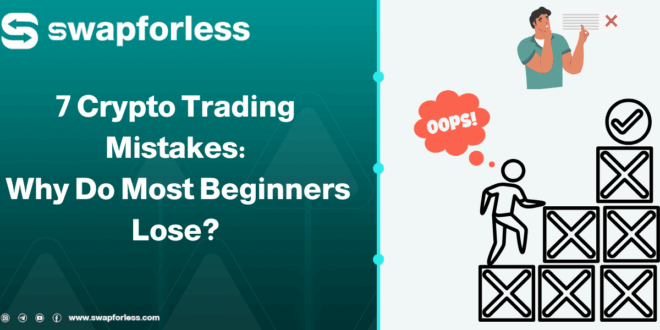Do you know anyone who has invested a little money in crypto and became wealthy within months? You might have heard of others who lost everything because of an adverse choice or an impulsive action.
The cryptocurrency market is both inspiring and tragic at the same time. The issue is not with the market but with the manner in which people engage with it.
So why is it that the overwhelming majority of novices make an exit empty-handed?
Most beginners join this world with high expectations but less understanding of its norms or challenges. And the consequence? Crypto Trading Mistakes happen so regularly that they result in major losses.
In this post, we shall discuss 7 Crypto Trading Mistakes, including tips on avoiding them.
Why do 90% of beginners fail in cryptocurrency trading?

Why are cryptocurrency beginners so bad at trading? The reason is not easy to explain, but it is representative of the discipline and the problems it presents.
The crypto market is totally different from conventional markets. The market is mostly unregulated, very volatile, and is significantly dependent upon numerous factors.
Statistics have revealed that 90% of beginner traders fail to sustain profits, and this is usually caused by habitual crypto trading mistakes that can be prevented by enhancing one’s awareness and planning.
One of the key reasons why so many people fail is that they jump into it without enough knowledge.
Cryptocurrency works on sophisticated technologies like blockchain, and it takes some efforts to learn about it. Still, numerous beginners assume that it is easy: buy at the right time, sell at the right time.
And then there is the issue of hands-on experience. Trading is more than luck or book knowledge; it is an art that has to be learned and honed.
Social media introduces another level of complexity. Social media is replete with tales of so-called “spectacular success.” Numerous individuals position themselves as so-called “experts” and present their success so that it appears to be effortless and enticing.
These tales have an influence on novices, who copy them without thorough analysis, thus making uninformed and hasty mistakes in crypto trading.
7 Common Crypto Trading Mistakes

Mistake 1: Not doing enough research
Many beginners fall into the trap of investing in projects simply because they are “the talk of the town,” without making a real effort to understand what is behind these projects.
For example, let’s say you invested in a new cryptocurrency because everyone around you is talking about it, but you didn’t understand the technology it relies on or the team behind it.
If this currency relies on unsustainable technology or an unqualified team, its chances of success will be very slim.
How to avoid this mistake?
- Start by understanding the basics: Understand how blockchain technology works, how cryptocurrencies work, and the difference between cryptocurrencies and tokens.
- Study the project: Check the development team, project vision, technology used, and the degree of applicability in the real world.
- Research more: Read reviews and reports from reliable sources instead of relying only on the opinions of celebrities on social media.
The difference between centralized and decentralized exchanges: Which is better?
CEX vs DEX: Unpacking the Key Differences in Crypto Trading
Mistake 2: Lack of a clear strategy

A strategy is a roadmap that defines how to achieve your goals. Without a clear strategy, you are like someone walking in a forest without a compass, prone to getting lost in every direction.
Many beginners enter the market without any plan, which makes them prone to making random decisions driven by emotion.
What are the components of a good strategy?
- Goals: Define what you want to achieve. Are you aiming for short-term daily trading or long-term investment?
- Risk management: Determine the percentage you will lose before exiting the trade (Stop-Loss), and the target percentage of profit.
- Periodic evaluation: Review your trading results monthly, and improve your strategy based on performance.
Mistake 3: Weak risk-to-reward ratio

Simply put, this ratio measures the balance between the risk you take versus the potential return you can achieve.
Many beginners enter trades where the risk is higher than the gain, causing them to lose in the long run , even if they achieve some profitable trades.
For example, imagine that you are investing in a cryptocurrency that you expect to rise by only 5%, but you are exposed to the risk of losing 20% of your capital if prices fall. This is not a good deal by any means.
How to avoid this mistake?
- Before entering any trade, determine the target profit level and the tolerable loss (Stop-Loss).
- Use the chart tools to assess growth opportunities based on existing historical data in the long term.
- Do not enter trades with low growth potential or high risks.
What is the ideal risk-to-reward ratio?
- A ratio of 1:2 or higher: This means that the potential gain should be at least double the potential loss.
Example: If you are willing to risk $100 in a trade, the profit target should be at least $200. - Avoid unbalanced trades: Such as risking $200 to profit only $50, these are unsustainable trades.
Even if 60% of your trades are losing, if you maintain a Risk/Reward ratio of 1:2, you will still be profitable in the long run due to the profitable trades compensating for the losses.
Mistake 4: Ignoring the use of Stop-Loss orders

One of the most capital-destructive crypto trading mistakes is neglecting the use of Stop-Loss orders.
Beginners believe they are smarter than the market and can predict all its movements, or that they can constantly monitor prices, or that patience will save them from losses.
How to avoid this mistake?
- Use a Stop-Loss order in every trade you make.
Set a Stop-Loss level based on a small percentage of capital (1-2%). - Do not rely on luck or assumptions that prices will rise again in case of significant losses, but rely only on technical analysis.
- In May 19, 2021, Bitcoin fell 30% in one day. Traders who used Stop-Loss exited with limited losses, while others lost a large portion of their capital.
Mistake 5: Emotional trading
Emotional trading is trading on the basis of feelings of fear or greed rather than on reason or strategy.
In the turbulent world of cryptocurrency, feelings turn into a destructive element that can convert an anticipated gain into an actual loss.
What does emotional trading look like?
- Fear of Missing Out (FOMO): Entering trades late simply because the price is rising rapidly, for fear of missing out. The result: buying at the peak, then watching the price collapse.
Many beginners bought SHIB in October 2021 when it was at its peak due to media hype, then lost more than 70% of their investments within weeks. - Greed trading (HODLing): Insisting on holding the currency even when there are signs of a market downturn, in the hope of greater gains. This leads to turning realized profits into losses.
- Revenge trading: After a trader suffers a significant loss, they may try to “recover” their money by making reckless decisions such as investing in new currencies without study or using leverage excessively. This behavior often leads to double losses.
Mistake 6: Investing more than you can afford to lose
One of the main characteristics of the cryptocurrency market is sharp fluctuations, where you can lose 50% of your investment in one day if you are not prepared.
Some beginners invest all their money in one currency, believing that if they succeed, it will be huge. But in reality, if the currency falls, they lose everything.
How to avoid this mistake?
- Use Stop-Loss orders: As mentioned earlier, set an automatic price to exit if the price falls by a certain percentage.
- Diversify your investments: Do not put all your money in one currency, but diversify across multiple assets to reduce risk.
- Do not invest more than you can afford to lose: Allocate only a portion of your savings to cryptocurrencies.
Mistake 7: Neglecting digital security
Digital security is one of the most important aspects that a trader should pay close attention to.
Cryptocurrencies rely on digital technology, making them vulnerable to hacking and fraud. However, many beginners neglect this aspect, leading to the easy loss of their money.
What are common security risks?
- Hacking personal accounts:
If you use weak passwords or have not enabled two-factor authentication (2FA), your accounts on trading platforms or digital wallets may be vulnerable to hacking. - Phishing:
Fraudsters use emails or fake links to steal your login details. If you click on a suspicious link, your money may be easily stolen. - Hacking hot wallets:
Hot wallets are wallets connected to the internet, such as applications or websites. Although they are convenient, they are more vulnerable to hacking compared to cold wallets. - Fake tokens:
Some fraudsters create fake cryptocurrencies that mimic the original ones. If you buy these tokens by mistake, you may lose all your money.
In conclusion:
If the cryptocurrency market is like a maze of both risks and opportunities, deciphering the maze is the way to safely and successfully find one’s way out of it.
The reality is that it is possible to be successful in this market without the status of so-called “experts” or professionals.
All people can join this world and gain from it, provided that they have the intention to learn and stick to the simple principles of risk management and making decisions.
By avoiding these crypto trading mistakes, you can immensely increase your likelihood of converting challenges into opportunities.
 swapforless blog
swapforless blog



